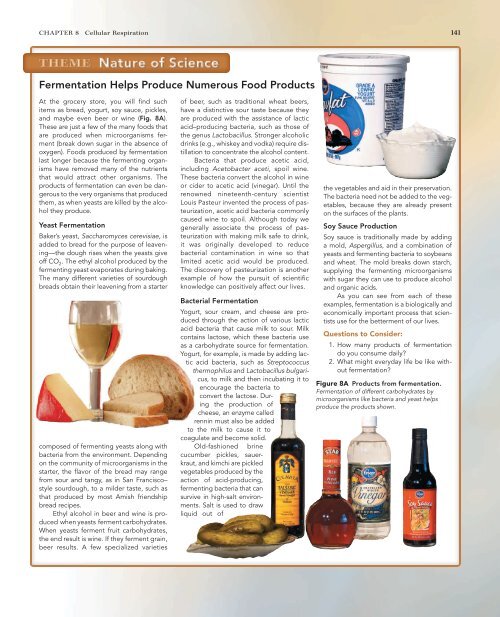Cellular Respiration
Cellular Respiration
Cellular Respiration
Create successful ePaper yourself
Turn your PDF publications into a flip-book with our unique Google optimized e-Paper software.
CHAPTER 8 <strong>Cellular</strong> <strong>Respiration</strong> 141<br />
THEME Nature of Science<br />
Fermentation Helps Produce Numerous Food Products<br />
At the grocery store, you will find such<br />
items as bread, yogurt, soy sauce, pickles,<br />
and maybe even beer or wine (Fig. 8A).<br />
These are just a few of the many foods that<br />
are produced when microorganisms ferment<br />
(break down sugar in the absence of<br />
oxygen). Foods produced by fermentation<br />
last longer because the fermenting organisms<br />
have removed many of the nutrients<br />
that would attract other organisms. The<br />
products of fermentation can even be dangerous<br />
to the very organisms that produced<br />
them, as when yeasts are killed by the alcohol<br />
they produce.<br />
Yeast Fermentation<br />
Baker’s yeast, Saccharomyces cerevisiae, is<br />
added to bread for the purpose of leavening—the<br />
dough rises when the yeasts give<br />
off CO 2. The ethyl alcohol produced by the<br />
fermenting yeast evaporates during baking.<br />
The many different varieties of sourdough<br />
breads obtain their leavening from a starter<br />
composed of fermenting yeasts along with<br />
bacteria from the environment. Depending<br />
on the community of microorganisms in the<br />
starter, the flavor of the bread may range<br />
from sour and tangy, as in San Francisco–<br />
style sourdough, to a milder taste, such as<br />
that produced by most Amish friendship<br />
bread recipes.<br />
Ethyl alcohol in beer and wine is produced<br />
when yeasts ferment carbohydrates.<br />
When yeasts ferment fruit carbohydrates,<br />
the end result is wine. If they ferment grain,<br />
beer results. A few specialized varieties<br />
of beer, such as traditional wheat beers,<br />
have a distinctive sour taste because they<br />
are produced with the assistance of lactic<br />
acid–producing bacteria, such as those of<br />
the genus Lactobacillus. Stronger alcoholic<br />
drinks (e.g., whiskey and vodka) require distillation<br />
to concentrate the alcohol content.<br />
Bacteria that produce acetic acid,<br />
including Acetobacter aceti, spoil wine.<br />
These bacteria convert the alcohol in wine<br />
or cider to acetic acid (vinegar). Until the<br />
renowned nineteenth-century scientist<br />
Louis Pasteur invented the process of pasteurization,<br />
acetic acid bacteria commonly<br />
caused wine to spoil. Although today we<br />
generally associate the process of pasteurization<br />
with making milk safe to drink,<br />
it was originally developed to reduce<br />
bacterial contamination in wine so that<br />
limited acetic acid would be produced.<br />
The discovery of pasteurization is another<br />
example of how the pursuit of scientific<br />
knowledge can positively affect our lives.<br />
Bacterial Fermentation<br />
Yogurt, sour cream, and cheese are produced<br />
through the action of various lactic<br />
acid bacteria that cause milk to sour. Milk<br />
contains lactose, which these bacteria use<br />
as a carbohydrate source for fermentation.<br />
Yogurt, for example, is made by adding lactic<br />
acid bacteria, such as Streptococcus<br />
thermophilus and Lactobacillus bulgaricus,<br />
to milk and then incubating it to<br />
encourage the bacteria to<br />
convert the lactose. During<br />
the production of<br />
cheese, an enzyme called<br />
rennin must also be added<br />
to the milk to cause it to<br />
coagulate and become solid.<br />
Old-fashioned brine<br />
cucumber pickles, sauerkraut,<br />
and kimchi are pickled<br />
vegetables produced by the<br />
action of acid-producing,<br />
fermenting bacteria that can<br />
survive in high-salt environments.<br />
Salt is used to draw<br />
liquid out of<br />
the vegetables and aid in their preservation.<br />
The bacteria need not be added to the vegetables,<br />
because they are already present<br />
on the surfaces of the plants.<br />
Soy Sauce Production<br />
Soy sauce is traditionally made by adding<br />
a mold, Aspergillus, and a combination of<br />
yeasts and fermenting bacteria to soybeans<br />
and wheat. The mold breaks down starch,<br />
supplying the fermenting microorganisms<br />
with sugar they can use to produce alcohol<br />
and organic acids.<br />
As you can see from each of these<br />
examples, fermentation is a biologically and<br />
economically important process that scientists<br />
use for the betterment of our lives.<br />
Questions to Consider:<br />
1. How many products of fermentation<br />
do you consume daily?<br />
2. What might everyday life be like without<br />
fermentation?<br />
Figure 8A Products from fermentation.<br />
Fermentation of different carbohydrates by<br />
microorganisms like bacteria and yeast helps<br />
produce the products shown.

















